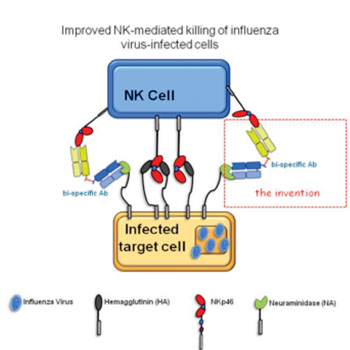Researchers Show How the Influenza Virus Blocks Natural Killer Cell Recognition
By LabMedica International staff writers
Posted on 01 Sep 2014
A team of molecular virologists has described how the influenza virus evolved a defense mechanism to protect it from attack by the immune system's natural killer (NK) cells.Posted on 01 Sep 2014
The recognition of pathogen-infected cells by the immune system's NK cells is controlled by inhibitory and activating receptors. Investigators at the Hebrew University of Jerusalem (Israel) had shown previously that among the activating NK cell receptors, the natural cytotoxicity receptors NKp44 and NKp46 interacted with the viral hemagglutinin (HA) protein expressed on the cell surface of influenza-virus-infected cells. The interaction between NKp44/NKp46 and viral HA was sialic-acid dependent, and the recognition of HA by NKp44 and NKp46 led to the elimination of the infected cells.

Image: Diagram illustrates the innovative process that could lead to more effective drugs against influenza infection (Photo courtesy of the Hebrew University of Jerusalem).
In the current study, which was published in the August 1, 2014, issue of the Journal of Infectious Diseases, the investigators demonstrated that the influenza virus developed a counter-attack mechanism based on the virus' neuraminidase (NA) protein. The NA enzyme removed HA sialic acid and prevented the recognition of the virus by the NKp44 and NKp46 receptors. This lack of recognition resulted in reduced elimination of the infected cells by NK cells.
Understanding the NA/HA interaction and its influence on NK cell behavior is expected to lead to the development of new approaches for treating influenza.
Influenza is a major global health problem causing approximately three to five million cases of severe illness and leading to between 250,000 and 500,000 deaths worldwide. “It is thus urgent to develop new drugs for fighting influenza infection, which requires an understanding of the virus's life cycle and its interaction with the host’s immune system,” said first author Yotam Bar-On, a research student in immunology and oncology at the Hebrew University of Jerusalem.
In recognition of the significance of his research, Yotam Bar-On was recently awarded the prestigious Kaye Innovation Award. This award was established by the prominent British pharmaceutical industrialist Isaac Kaye to encourage faculty, staff, and students of the Hebrew University of Jerusalem to develop innovative methods and inventions with good commercial potential which will benefit the university and society.
Related Links:
Hebrew University of Jerusalem













